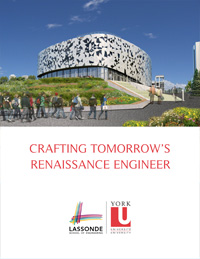Crafting tomorrow’s Renaissance Engineer
By: Mudeeha Yousaf
York University embraces its new professional engineering school– a structure that evokes cloud imagery and is intended to motivate students to mirror its unique craftsmanship and apply it within their own educational vocations. York’s Keele Campus in Toronto is home to the Lassonde School of Engineering, a faculty initiated in November 2011 with the vision of transforming the engineering profession through a specialized educational experience that melds creativity with collaboration, and seeks to eliminate traditional barriers of communication between disciplines.
Provoking a New School of Thought
The visionaries behind the groundbreaking project will have a hand in sculpting the ‘Renaissance Engineer’ – a global citizen with a level of social consciousness and entrepreneurial know-how. Renaissance Engineers strive to view, understand and change the world from a political and sustainable standpoint and apply philanthropic principles along the way. “We want our students to understand the major cultures and religions in the world and speak more than one language,” says Founding Dean of the Lassonde School of Engineering, Janusz Kozinski. As agents of social change, students will embark on a journey based on an extension of textbook learning to include humanism and a spirit of ingenuity. It is with this in mind that the institution will move away from traditional lecture theatres and instead create natural spaces where students can discuss concepts freely and engage in social interaction at their own pace. “The building’s non-traditional design represents the notion that engineers should be polyvalent and collaborate within a cloud to produce tangible results,” adds Richard Francki, Assistant Vice President, Campus Services & Business Operations.
“We want to build on the notion of future engineers working harmoniously.” Students will have access to lectures at their own time and pace, whether in the classroom or at home, and when they come to the university they will focus on solving problems in collaboration with professors and other students. Kozinski advocates for this flexibility in learning: “The key in engineering is to practice and make things happen. You don’t do this by spending time in lectures.”
Groundbreaking Design
Founding donor Pierre Lassonde provided a $25M donation to spearhead the project, principally targeted towards faculty operating costs. Subsequently Ontario’s Ministry of Training, Colleges & Universities granted $50 million towards its construction, and York University completed the financial backing with the addition of $35 million.
A $5-million donation from Ignat Kaneff, Chairman and CEO of the Kaneff Group of Companies also supports the new School of Engineering, and will be used principally to support the renovation of additional campus space required by the engineering program. A research tower at York has been named the Kaneff Tower in recognition of this donation.
It is with this support from the government, community, faculty, staff and students that the institution has coveted a reputation of high architectural merit. The unorthodox facade of the new building and its curvilinear design will be attractive to the most talented professors and enterprising students from around the globe, drawn towards its flexible spaces and futuristic learning methods. “The natural setting for the building was an inspiration and provided an opportunity with significant public visibility from a distance. We can take advantage of this new building to provide a new face to the campus,” says Francki. “The curvilinear facade of the building responds well to the natural landscape of the adjacent pond and arboretum.”
The holistic design and its architectural elegance are the result of a rigorous design process. ZAS Architects + Interiors have had their hands full in completing the 169, 000 sq. ft, five-storey cloud design. The construction project undertaken by Laing O’Rourke as the Construction Manager in partnership with the Gillam Group came with its own set of challenges, including the usual weather-related issues and the acquisition of municipal approvals and building permits under tight deadlines. Not only is the physical construction of the building challenging, but the project is being also being constructed at a time when the university is host to a large number of other significant capital projects, including two new subway stations, a new Life Sciences building (recently completed) and the athletics stadium for the 2015 Pan American Games. In the offing are a new student residence and a new student centre. Notwithstanding the rigors of the multiple construction activities, the University is pleased to provide the many economic benefits that the projects will undoubtedly bring to the Ontario student community.
The special purpose building is also utility and energy conscious with a perspective to reduce utility consumption. “We at York have embraced sustainable development. It manifests itself through the building which has LEED Silver as the design objective, and is positioned to achieve LEED Gold,” says Francki. With an eye towards 21st-century learning, the institution will encompass evolutionary technologies through the expansion of existing building automation systems to control the environment and consumption of utilities. As well, digitally controlled glass will be installed that will selectively increase or decrease the dimming in the large panels of glass, allowing the minimization of solar glare or the optimization of solar heat at the stroke of a switch.
Vision for the Future
Prior to constructing the new engineering school, the likes of which has not been built in Canada for over 40 years, extensive research was conducted where industry leaders, governments, businesses and alumni were consulted to find out what was lacking in their education, and the majority stated that it was the opportunity to learn more about the nature of business and legal issues simultaneously. The new program will incorporate a crossover program with York University’s Schulich School of Business and Osgoode Hall Law School to ensure that students receive a practical outlook that can only be found through real-time accessibility.
Applications to Lassonde rose by 74.8 percent for 2014, and of this unprecedented surge in numbers, 27 percent are female candidates – a significant leap from the current percentage of women in the student bodyof the Faculty of Engineering. “We want to be known as an engineering school that is the first choice for female engineers,” says Kozinski. “Our goal is to have a gender equilibrium in engineering.”
“If you create a new academic entity, the first cohort or two of people will determine your culture and quality. We really wanted to hire excellent professors and wanted to bring first-class students. Thanks to successful fundraising, we were able to establish top scholarships in Canada.” The university offers a Lassonde Scholarship of $80, 000 over four years to those dynamic students who are interested in changing the world. The school has recently entered into a strategic partnership with the Technion Israel Institute of Technology in Haifa – the world’s largest public research university offering degrees in science and technology — that will allow 25 Lassonde students exposure to the practical meaning of entrepreneurship in an extensive 3-week summer program, the first phase of which will begin August 17th of this year.
The Next Chapter of the Engineering Profession
The progressive Lassonde School of Engineering is on track to open its doors September 1, 2015, and will drive academia forward through a bold new interface. Its visible presence will change York University’s position in the education hierarchy, exceptional programs will craft the brightest minds of tomorrow, and the inimitable design breaks the mold in architectural novelty. As Kozinski notes, “We are contributing to the resource that is most valuable to Canada, which isn’t natural resources, oil or gold, but people—and in particular young people.”







